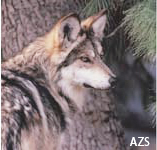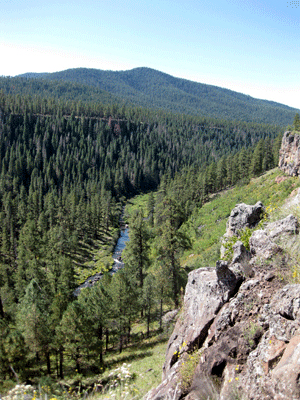Leopold and a New Vision for Predators
In 1909, Aldo Leopold started his career with the Forest Service on the Apache-Sitgreaves National Forest in Arizona. Leopold would go on to be one of the most  influential voices in the 20th century environmental movement. His collection of essays, A Sand County Almanac, has inspired generations of conservationists. One of the most moving essays in the Almanac is “Thinking Like a Mountain.” In this essay Leopold recounts the killing of a wolf and how the death became a transformational moment in his life.
influential voices in the 20th century environmental movement. His collection of essays, A Sand County Almanac, has inspired generations of conservationists. One of the most moving essays in the Almanac is “Thinking Like a Mountain.” In this essay Leopold recounts the killing of a wolf and how the death became a transformational moment in his life.
Aldo Leopold is renowned for his recounting of the “fierce green fire” dying in the wolf’s eyes:
“In those days we had never heard of passing up a chance to kill a wolf. In a second we were pumping lead into the pack, but with more excitement than accuracy; how to aim a steep downhill shot is always confusing. When our rifles were empty, the old wolf was down, and a pup was dragging a leg into impassable side-rocks”¦.
“We reached the old wolf in time to watch a fierce green fire dying in her eyes. I realized then, and have known ever since, that there was something new to me in those eyes—something known only to her and to the mountain. I was young then, and full of trigger-itch; I thought that because fewer wolves meant more deer, that no wolves would mean hunters’ paradise. But after seeing the green fire die, I sensed that neither the wolf nor the mountain agreed with such a view”¦
“Since then I have lived to see state after state extirpate its wolves. I have watched the face of many a newly wolfless mountain, and seen the south-facing slopes wrinkle with a maze of new deer trails. I have seen every edible bush and seedling browsed, first to anaemic desuetude, and then to death. I have seen every edible tree defoliated to the height of a saddlehorn. Such a mountain looks as if someone had given God a new pruning shears, and forbidden Him all other exercise. In the end the starved bones of the hoped-for deer herd, dead of its own too-much, bleach with the bones of the dead sage, or molder under the high-lined junipers.”
Leopold, Aldo: “Thinking Like a Mountain,” A Sand County Almanac. 1966, Ballantine Books, p. 137-139.
In his essay, Leopold portrayed the event as a transformational moment in his life. However we know that the transformation actually occurred over a longer period of time. The incident itself is almost an aside in a 1909 letter—he was much more concerned over the loss of his pipe. For over 15 years after the incident, Leopold was still calling for the eradication of all “varmints,” including wolves. Leopold was raised believing that predators needed to be eradicated because they reduced the number of game species such as deer. Old beliefs die hard.
After years of observation, Leopold the scientist abandoned this belief, realizing that top predators act as a critical balancing force in ecosystems. Over the years, Leopold observed what happened when wolves were removed from the environment. He saw that the removal of predators resulted in the explosive growth in deer populations in the Gila Mountains, the North Kaibab plateau, and northern Wisconsin. These periods of growth were followed by over browsing and eventual mass starvation of deer populations. During trips that Leopold took in 1934 and 1935 to the Rio Gavilan in northern Mexico, he observed that predators and deer lived in a balance that was missing from places where wolves had been exterminated. His “Thinking Like a Mountain” essay is actually an apology for the hand he had in exterminating wolves from the wild. These observations led him to break with conventional wisdom and begin to see lands as systems—interconnected systems—where all parts played a critical role:
Harmony with the land is like harmony with a friend. You cannot cherish his right hand and chop off his left. That is to say you cannot have game and hate predators. The land is one organism (emphasis added).
Leopold, Aldo: “Round River,” A Sand County Almanac. 1966, Ballantine Books, p. 189.
 Although the dying of the “fierce green fire” haunted Leopold for years, connecting the wolf to the health of the land inspired him to promote a very unpopular idea—predators matter to our ecosystems. He believed, as many of us now do, that living systems are interconnected with all native organisms critical to the health of the land. He was far ahead of his time when he proclaimed:
Although the dying of the “fierce green fire” haunted Leopold for years, connecting the wolf to the health of the land inspired him to promote a very unpopular idea—predators matter to our ecosystems. He believed, as many of us now do, that living systems are interconnected with all native organisms critical to the health of the land. He was far ahead of his time when he proclaimed:
“The outstanding scientific discovery of the twentieth century is not television, or radio, but rather the complexity of the land organism. Only those who know the most about it can appreciate how little we know about it. The last word in ignorance is the man who says of an animal or plant: “What good is it?” If the land mechanism as a whole is good, then every part is good, whether we understand it or not. If the biota, in the course of aeons, has built something we like but do not understand, then who but a fool would discard seemingly useless parts? To keep every cog and wheel is the first precaution of intelligent tinkering” (emphasis added).
Leopold, Aldo: Round River, Oxford University Press, New York, 1993, pp. 145-146.
Learn more about Aldo Leopold at the Leopold Foundation . Click here to read about the proposed Green Fire Trail.



